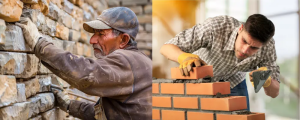Masonry Restoration is the process of cleaning, repairing, and revitalizing brick and stone structures. It also includes repointing (filling in and repairing joints) to prevent further deterioration.
Masonry restoration requires specialized tools like a hammer and chisel for breaking old mortar, a trowel for spreading new mortar, and a stiff brush for cleaning out old mortar joints. It also involves preserving the historical and cultural significance of the building.

Repairing damaged bricks is a vital part of Masonry Restoration. This is done by either cleaning and repointing the area or replacing the broken brick. When a brick is cracked or chipped, it is important to have it repaired quickly to avoid more serious issues. A professional masonry contractor can use various tools to clean and repair brick, including brushes and sponges to remove any debris in the crack. They may also need to apply a protective coating to protect the brick from moisture.
A damaged brick can be replaced by a new one that matches the color and texture of the rest of the building. To replace a brick, first, the old brick must be removed using a drill or angle grinder and a cold chisel. Then, the opening is filled with mortar.
When the hole is dry, the new brick can be placed. The masonry contractor must be careful to place the brick so it is not exposed to moisture. Moisture can cause deterioration in brick and lead to more extensive repairs. It is best to install a gutter system to move water away from the structure and prevent standing water in the pores of the brick.
Damaged bricks can increase the cost of a building, but if they are repaired promptly, it will save money in the long run. In addition, it can help to reduce air infiltration and improve energy efficiency. Additionally, a well-maintained masonry building will add to the curb appeal of a home or business and can raise its value.
Repointing
Masonry-brick, stone, and terra cotta-is the most common material found in historic buildings. While it is durable, it is also vulnerable to deterioration, particularly at the mortar joints. Repointing-also known as tuck pointing-removes deteriorated mortar from the joints of a brick wall and replaces it with new mortar to restore the structural integrity of the building. Properly done, repointing not only improves the appearance of a structure, but it can also prevent further damage from occurring to the masonry units themselves.
Repointing is important because deteriorating mortar joints can allow water to seep into the brick or stone walls, causing further deterioration and eventually leading to structural instability of the wall. Fortunately, by addressing the problem in its early stages with repointing, you can protect your historic masonry from expensive and time consuming repair processes.
The process of repointing begins with cleaning the masonry to remove dirt, pollutants, and layers of previous coatings. This unveils the true color and texture of the original materials. Next, a mechanical angle grinder is used to carefully remove the deteriorated mortar from the joints of the brick wall. The remaining voids are then filled with new mortar that closely matches the original mortar’s composition and color.
When repointing, it is best to use rounded sand instead of crushed or manufactured sand. This type of sand has a more similar texture to the sand in the historic mortar and is more likely to match the strength and permeability characteristics of the historic mortar. This ensures that the new repointing will blend in with the existing mortar rather than stand out as an obvious repair. Repointing is a highly skilled process that requires both experience and a careful eye to properly execute.
Rebuilding
Masonry structures, whether they are made of brick or stone, can benefit from regular maintenance to maintain their structural integrity and visual appeal. While masonry restoration can range from simply repointing mortar joints to rebuilding entire sections of a building, all projects begin with a thorough assessment and evaluation of the structure1.
Once the professionals have identified areas of deterioration and damage, they will develop a comprehensive repair plan that will include all necessary repairs. This includes determining the type of materials needed to match the existing texture, color, and composition of the masonry and then sourcing those materials to restore the masonry to its original condition. In some cases, this may involve removing damaged materials and reconstructing the masonry using new, period-appropriate materials.
As part of the masonry restoration process, contractors will also apply specialized coatings or stains to the surface of the structure to protect and enhance its appearance. They may also install soffit vents or other architectural elements to promote proper air circulation and help prevent the buildup of moisture and other damaging environmental factors.
The benefits of masonry restoration extend well beyond aesthetics. It can improve energy efficiency by reducing the amount of heat or cold that is lost through cracked and crumbling masonry. It can also improve lateral resistance by reinforcing the masonry against forces like wind or earthquakes. And finally, the preservation of historic buildings through masonry restoration helps preserve our cultural heritage.
It is important for commercial property owners to perform regular masonry restoration to ensure their buildings look good and function properly. Without maintenance, masonry will eventually begin to decay, which can lead to safety issues and costly repairs in the future.
Preserving Architectural Details
When performing Masonry Restoration on historic buildings, the contractors must take a great deal of care to preserve any architectural details that might have been there originally. This is important because such features are what makes a building distinctive and iconic, and it is important to preserve that appearance as much as possible while keeping any preservation regulations in mind.
This might mean that some of the original materials will need to be replaced, but it also might mean reusing existing materials where possible. It is important to understand that these types of projects are very complex and should be handled by professionals with the proper training and experience.
For example, if it’s necessary to replace mortar, the contractor must do so using a mix that closely matches what was used in the original construction. This is not easy, and it requires skill and care to make sure that the replacement mortar is not only structurally sound but also looks the same as the original material.
Similarly, if it’s necessary to replace bricks or stones, they must be carefully selected to match the original appearance of the structure. This may also require the use of specialized tools and techniques. It is also important to ensure that the replacement material is treated in a way that protects it from further damage and deterioration.
It is often a good idea to contact a professional masonry restoration specialist before any serious problems occur. This is because these specialists can spot issues that an untrained eye might miss. This allows them to address small problems before they have a chance to grow into significant and costly ones. In addition, regular inspections by a qualified professional can prevent future damages from occurring and extend the lifespan of the structure.
Finishing Touches
The final step in a successful masonry restoration project is to apply protective coatings or sealants. This protects the structure from damage and keeps it looking great for years to come. The type of coating used will depend on the condition of the brick or stone and the desired aesthetic.
Masonry restoration is an important service that enhances the beauty of buildings and public spaces while preserving their structural integrity. It’s a complex process that involves many different techniques, materials, and tools. Hiring a professional is essential to ensure quality work that stands the test of time.
Expert masonry technicians have the skills and experience needed to perform repairs and restore structures. They understand the unique quirks of different masonry materials and can spot issues that may go unnoticed by someone with less experience. Professionals also have access to specialized equipment that is often unavailable to DIY enthusiasts. This can save time and improve the outcome of a project.
A masonry restoration team will begin by conducting an assessment of the damaged structure. This will involve identifying the underlying causes of damage, such as water infiltration or structural movement. This information will help the masonry team develop a plan of action that addresses the root cause rather than treating the symptoms. The masonry restoration team will then repair the affected areas. This can include tuckpointing, brick or stone replacement, surface cleaning, and the application of protective coatings. Once the new mortar has dried, it will need to be sanded and smoothed to create a consistent finish. The sanding process will also help to create the distinct, contrasting lines that give tuckpointing its characteristic look.

